Firefighting
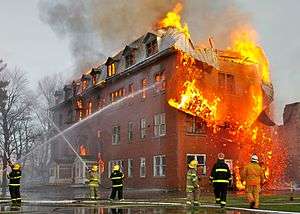
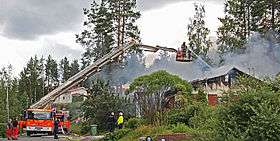
Firefighting is the act of extinguishing fires. A firefighter suppresses and extinguishes fires to protect lives and to prevent the destruction of property and of the environment.[1] Firefighters may provide other valuable services to their communities, including emergency medical services.
Firefighters typically undergo a high degree of technical training,[1][2] in both general firefighting techniques and developing specialist expertise in particular fire and rescue operations, such as aircraft/airport rescue, wilderness fire suppression, and search and rescue.
One of the major hazards associated with firefighting operations could possibly be the toxic environment created by combustible materials, the four major risks are smoke, oxygen deficiency, elevated temperatures, and poisonous atmospheres.[3] Additional hazards include falls and structural collapse that can exacerbate the problems entailed in a toxic environment. To combat some of these risks, firefighters carry self-contained breathing equipment.
The first step in a firefighting operation is reconnaissance to search for the origin of the fire, to identify the specific risks, and to locate possible casualties.
Fires can be extinguished by water, fuel removal, or chemical flame inhibition.
History

The earliest known firefighters were in the city of Rome. In 60 A.D., emperor Nero established a Corps of Vigils (Vigiles) to protect Rome after a disastrous fire. It consisted of 7,000 people equipped with buckets and axes, and they fought fires and served as police.[4]
Historic tactics and tools
In the 4th century B.C., an Alexandrian Greek named Ctesibius made a double force pump called a siphona. As water rose in the chamber, it compressed the air inside, which forced the water to eject in a steady stream through a pipe and nozzle.[4]
In the 16th century, syringes were also used as firefighting tools, the larger ones being mounted on wheels.[4] Another traditional method that survived was the bucket brigade, involving two lines of people formed between the water source and the fire. Typically, men in one of the lines would pass along the full buckets of water toward the fire while in the other line women and children would pass back the empty buckets to be refilled.[4]
In the 17th century, 'fire engines' were made, notably in Amsterdam.[4] In 1721, the English inventor Richard Newsham made a popular fire engine that was essentially a rectangular box on wheels filled using a bucket brigade to provide a reservoir while hand-powered pumps supplied sufficient water pressure to douse fires at a distance.[4]
Ancient Rome
Ancient Rome did not have municipal firefighters. Instead, private individuals relied on their slaves or supporters to take action. They would not only form bucket brigades or attempt to smother smaller fires, but would also demolish or raze nearby buildings to slow the spread of the fire. However, there is no mention of fires being extinguished, rather they were contained and burned themselves out. Ancient Rome did not have an organized firefighting force until the Vigiles were formed in the reign of Augustus.[5]
United Kingdom
Prior to the Great Fire of London in 1666, some parishes in the UK had begun to organize rudimentary firefighting. After the Great Fire, Nicholas Barbon introduced the first fire insurance. In order to reduce insurance costs, Barbon also formed his own fire brigade, and other companies followed suit.
By the start of the 1800s, insured buildings were identified with a badge or mark, indicating that they were eligible for firefighting services. (Buildings with no coverage, or insurance with a different company, were left to burn,[6] unless they happened to be adjacent to an insured building, in which case it was often in the insurance company's interest to prevent the fire from spreading.) In 1833, these companies in London merged to form The London Fire Company Establishment.
Steam powered apparatuses were first introduced in the 1850s, allowing a greater quantity of water to be directed onto a fire, and in the early 1930s, they were superseded by versions powered by an internal combustion engine.
In World War II, the Auxiliary Fire Service and later the National Fire Service were established to supplement local fire services. At that time, there was no countrywide standard for firefighting terms, procedures, ranks, or equipment (such as hose couplings). These were standardized after World War II.
United States
In January 1608, a fire destroyed many of the colonists' provisions and lodgings in Jamestown, Virginia. Boston, New York City, and Philadelphia were all plagued by fires, and volunteer fire brigades formed soon after such disasters.[7]
In 1736, Benjamin Franklin founded the Union Fire Company in Philadelphia, which became the standard for volunteer fire organizations. These firefighters had two critical tools: salvage bags and so-called bed keys. Salvage bags were used to quickly collect and save valuables, and bed keys were used to separate the wooden frame of a bed into pieces for safe and rapid removal from the fire.[7]
The first American attempt at fire insurance failed after a large fire in Charlestown, Massachusetts in 1736. Later in 1740, Benjamin Franklin organized the Philadelphia Contributionship to provide fire insurance, which was more successful. The Contributionship adopted "fire marks" to easily identify insured buildings. Firefighting started to become formalized with rules for providing buckets, ladders, and hooks, and with the formation of volunteer companies. A chain of command was also established.[7]
Firefighter duties
A firefighter's goals are to save lives, property, and the environment.
A fire can rapidly spread and endanger many lives, but with modern firefighting techniques, catastrophe can often be avoided.
To prevent fires from starting, a firefighter's duties may include public education about fire safety and conducting fire inspections of locations to verify their adherence to local fire codes.

Firefighter skills

Firefighting requires skills in combating, extinguishing, and preventing fires, answering emergency calls, operating and maintaining fire department equipment and quarters, and extensive training in performing firefighting and rescue activities. Firefighters must also have (or be able to acquire) knowledge of department organizations, operations, and procedures,[4] and the district or city street system[4] they will have to negotiate in order to perform their duties.
They must meet minimum physical fitness standards and learn various firefighting and rescue duties within a reasonable period,[4] including how to assist people in critical condition as a first responder, and provide other community services in addition to firefighting, such as:
- Emergency medical services, as technicians or as licensed paramedics staffing ambulances;
- Vehicle rescue/extrication;
- Defensive hazardous materials mitigation (HAZMAT);
- Community disaster support;
- Fire risk assessment.
Specialized skills
Specialized areas of fire and rescue operations may require subject-specific training.[8][9]
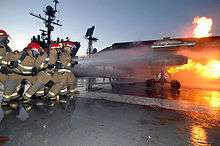
Examples are:
- Aircraft/airport rescue
- Building collapse
- Emergency Medical Services
- Cold-water rescue
- Confined space rescue
- High-angle rope rescue
- Offensive hazardous materials technician services (HAZMAT)
- Search and rescue
- Shipboard and military fire and rescue
- Swift water rescue
- Tactical paramedic support ("SWAT medics")
- Tool hoisting
- Trench rescue
- Wildland fire suppression
Shift hours
Firefighters typically follow a 24-hour shift schedule, although some fire departments work eight or 12 hour shifts.[10] Australian firefighters work a 10/14 shift, in which the day shift works ten hours and the night shift works 14 hours.[11] Firefighting personnel are split up into alternating shifts. Usually, the 24 hour shifts are followed by two days off.[4] The shift personnel arrive for roll call at a specified time, ready to complete a regular tour of duty.[4] While on shift, the firefighter remains at the fire station unless relieved or assigned other duties.[4] Everyone is expected to keep their protective clothing on until after roll call.[4] Finally, no one is excused from duty except in the case of an extreme emergency.[4]
Fire wardens
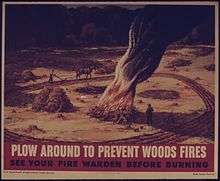
In fire fighting, there are also people designated as fire wardens, also known as the chief officer. Their duties vary, some may ensure evacuation of that part of the building for which they are responsible; others may be responsible for fire control in a particular area, direct a crew in the suppression of forest fires, or function as fire patrolmen in a logging area.[12]
The chief officer is in charge of his firefighters during fires or emergencies, and he is expected to command and control the overall situation while effectively combating a fire or other emergency.[4] Chief officers must be able to evaluate their firefighters, use sound judgement when deciding when it is time to withdraw firefighters from a fire, and react calmly in emergency situations.[4] The chief officer must direct the activities of a fire department and supervise all firefighting and rescue activities. In addition, he must have extensive knowledge of the city, the location of streets, fire hydrants and fire alarm boxes, and the principal buildings.[4] Also he must have knowledge of explosives, hazardous chemicals, and the combustion qualities of materials in buildings, homes, and industrial plants.[4]
In certain jurisdictions, civilians can get certified to be a Fire Warden, and some cities require certain types of buildings, such as high rises, to have a certain number of Fire Wardens. For example, the City of Houston, Texas, requires every tenant in a high-rise to have at least one Fire Warden for every 7500 sq. ft. occupied, and a minimum of two Fire Wardens per floor.[13] In this example, their duties include investigating any fire alarms (see if there really is a fire and if so, its nature), ensuring the fire department is contacted, directing the evacuation of the facility, activating or delaying activation of fire suppression equipment such as halon and sprinklers (delayed in case of a false alarm), meeting the fire department and taking them to the location of the alarm or to the fire past any security or locked doors, and, if necessary, fighting the fire until the fire department arrives.
Hazards caused by fire

One of the major hazards associated with firefighting operations is the toxic environment created by combusting materials. The four major hazards are:[14]
- Smoke, which is becoming increasingly dangerous due to the increased variety and amount of synthetic household materials.
- Oxygen deficient atmosphere, 21% O2 is normal, 19.5% O2 is considered oxygen deficient.
- Elevated temperatures
- Toxic atmospheres
To deal with such hazards, firefighters carry a self-contained breathing apparatus (SCBA; an open-circuit positive pressure system) to prevent smoke inhalation. These are not oxygen tanks (oxygen as a powerful fire accelerant would represent a grave risk when combined with virtually anything combustible in the presence of fire) but use compressed air in a similar manner to SCUBA diving gear. A firefighter's SCBA usually hold 30 to 45 minutes of air, depending on the size of the tank and the rate of consumption during strenuous activities. While this gear helps to eliminate the risks, firefighters are still exposed to smoke, toxic dust and fumes that have contributed to firefighters being 14% more likely to develop cancer.
Obvious risks associated with the immense heat generated by a fire, even without direct contact with the flames (direct flame impingement), such as conductive heat and radiant heat, can cause serious burns even from great distances. There are a number of comparably serious heat-related risks, such as burns from hot gases (e.g., air), steam, and hot and/or toxic smoke. Accordingly, firefighters are equipped with personal protective equipment (PPE) that includes fire-resistant clothing such as Nomex or polybenzimidazole fiber (PBI) and helmets that limit the transmission of heat towards the body. No PPE, however, can completely protect the user from the effects of all possible fire conditions.[15]
Heat can cause flammable liquid contained in tanks to explode violently, producing what is called a BLEVE (boiling liquid expanding vapor explosion).[16] Some chemical products such as ammonium nitrate fertilizers can also explode, potentially causing physical trauma from blast or shrapnel injuries. Sufficient heat causes human flesh to burn as fuel, or the water within to boil, leading to potentially severe medical problems.
Depending on the heat of the fire, burns can occur in a fraction of a second.
Additional risks of fire are the obscuring of vision due to smoke, potentially causing a fall or disorientation; becoming trapped in a fire; and structural collapse.[17]
"Three hours of fighting a fire stiffens arteries and impairs cardiac function in firefighters" according to a new study by Bo Fernhall, a professor in the department of kinesiology and community health in the College of Applied Health Sciences, and Gavin Horn, director of research at the Illinois Fire Service Institute. The conditions (observed in healthy male firefighters) are "also apparent found in weightlifters and endurance athletes..."[18]
Reconnaissance and "reading" the fire
The first step in a firefighting operation is reconnaissance to search for the origin of the fire (which may not be obvious for an indoor fire, especially if there are no witnesses), to identify any specific risks, and to detect possible casualties. An outdoor fire may not require reconnaissance, but a fire in a cellar or an underground car park with only a few centimeters of visibility may require long reconnaissance to identify the source of the fire.
The "reading" of a fire is the analysis by firefighters of indications of thermal events such as flashover, backdraft or smoke explosion. It is performed during reconnaissance and fire suppression maneuvers.
The main signs are:
- Hot zones, which can be detected with a gloved hand, for example by touching a door before opening it;
- Soot on windows, which usually means that combustion is incomplete, and thus, a lack of air in the room;
- Smoke pulsing in and out around a door frame, as if the fire were breathing, which usually also means a lack of air to support combustion.
Spraying water on the ceiling in short pulses of a diffused spray (e.g., a cone with an opening angle of 60°) can be undertaken to test the heat of smoke: If the temperature is moderate, the water falls down in drops with a sound like rain; if the temperature is high, the water vaporizes with a hiss—the sign of a potentially extremely dangerous impending flashover.
Ideally, part of reconnaissance is consulting an existing pre-plan for the building that provides information about existing structures, firefighter hazards, and in some cases the most appropriate strategies and tactics for fighting a fire in that context.
Science of extinguishment
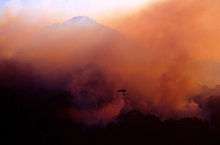
There are four elements[19] needed to start and sustain a fire and/or flame. These are a reducing agent (fuel), Heat, an oxidizing agent (oxygen), and a chemical reaction. A fire can be extinguished by taking away any of the four components.[19]
The fuel is the substance being oxidized or burned in the combustion process. The most common fuels contain carbon along with combinations of hydrogen and oxygen. Heat is the energy component of a fire. When it comes into contact with a fuel, it provides the energy necessary for ignition, causes the continuous production and ignition of fuel vapors or gases so that the combustion reaction can continue, and causes the vaporization of solid and liquid fuels. The resulting self-sustained chemical chain reaction is complex and requires fuel, an oxidizer, and heat energy to come together in a very specific way. An oxidizing agent is a material or substance that will release gases, including oxygen, when the proper conditions exist. It is crucial to the sustainment of a flame or fire.
Using water is one common method to extinguish a fire. Water extinguishes a fire by cooling, which removes heat because of water’s ability to absorb massive amounts of heat as it converts to water vapor. Without heat, the fuel cannot keep the oxidizer from reducing the fuel in order to sustain the fire. Water also extinguishes a fire by smothering it. When water is heated to its boiling point, it converts to water vapor. When this conversion takes place, it dilutes the oxygen in the air above the fire, thus removing one of the elements that the fire requires to burn. This can also be done with foam.
Another way to extinguish a fire is fuel removal. This can be accomplished by stopping the flow of liquid or gaseous fuel, by removing solid fuel in the path of a fire, or by allowing the fire to burn until all the fuel is consumed, at which point the fire will self-extinguish.
One final extinguishing method is chemical flame inhibition. This can be accomplished by applying dry chemical or halogenated agents that interrupt the chemical chain reaction and stop flaming. This method is effective on gas and liquid fuel; because, they must have flame to burn.
Sound waves have been successfully used in a device fabricated by two George Mason University senior engineering students, Viet Tran and Seth Robertson, but the procedure is still awaiting a patent (2015).[20]
Use of water
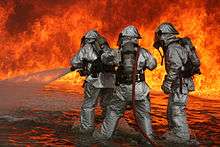

One common way to extinguish a fire is to spray it with water. The water has two roles: It vaporizes when it comes in contact with fire, and this vapor displaces the oxygen (the volume of water vapor is 1,700 times greater than liquid water, at 1,000 °F (538 °C) it expands over 4,000 times). This leaves the fire without enough of the combustive agent, and it dies out.[16] The vaporization of water also absorbs heat; it thereby cools the smoke, air, walls, and objects that could act as further fuel, and thus prevents one of the means by which fires grow, which is by "jumping" to nearby heat/fuel sources to start new fires, which then combine. Water extinguishment is thus a combination of "asphyxia" (cutting off the oxygen supply) and cooling. The flame itself is suppressed by asphyxia, but the cooling is the most important element in mastering a fire in a closed area.
Water may be accessed from a pressurized fire hydrant, pumped from water sources such as lakes or rivers, delivered by tanker truck, or dropped from water bombers, which are aircraft adapted as tankers for fighting forest fires. An armored vehicle (firefighting tank) may be used where access to the area is difficult.
Open air fire
For outdoor fires, the seat of the fire is sprayed with a straight spray: the cooling effect immediately follows the "asphyxia" caused by vaporization and reduces the further amount of water required. A straight spray is used so the water arrives massively to the seat of the fire before it vaporizes. A strong spray may also have a mechanical effect; it can disperse the combustible product and thus prevent the fire from starting again. Spray is always aimed at a surface or an object. For this reason, the strategy is sometimes called a two-dimensional or 2D attack.
An outdoor fire is always fed with air, and the risk to people is limited as they can move away from it, except in the case of wildfires or bushfires where they risk being easily surrounded by the flames. It might, however, be necessary to protect specific objects like houses or gas tanks against infrared radiation, and thus to use a diffused spray between the fire and the object. Breathing apparatus is often required as there is still the risk of inhaling smoke or poisonous gases.
Closed volume fire

Until the 1970s, fires were usually attacked while they declined, using the same strategy as for open air fires. Now fires are attacked in their development phase because firefighters arrive sooner at the site of a fire and because of changes in building construction. The increasing use of thermal insulation confines the heat, and modern materials, especially polymers, produce much more heat than do traditional materials like wood, plaster, stone, and bricks. Under these conditions, there is a greater risk of backdraft and flashover.
Directly spraying the seat of the fire in enclosed areas can have unfortunate consequences: the force of water pushes air in front of it, which supplies the fire with extra oxygen before the water. The most important issue is not combating the flames, but controlling the fire; for example, cooling the smoke so that it cannot spread and start fires further away, and endanger the lives of people, including the firefighters.
The volume of the fire must be cooled before its seat is attacked. This strategy, originally of Swedish origin (Mats Rosander & Krister Giselsson), was adapted by London Fire Officer Paul Grimwood following a decade of operational use in the busy West End of London between 1984 and 1994[21] and termed the three-dimensional or 3D attack.
Use of a diffuse spray was first proposed by Chief Lloyd Layman of the Parkersburg Fire Department, at the 1950 Fire Department Instructors Conference (FDIC) held in Memphis. Using Grimwood's modified 3D attack strategy, the ceiling is first sprayed with short pulses of a diffuse spray. This cools the smoke which is then less likely to start a fire when it moves away. As gas cools it becomes denser (Charles's law); thus, it also reduces the mobility of the smoke and avoids a "backfire" of water vapor. Also, the diffuse spray creates an inert "water vapor sky", which prevents "roll-over" (rolls of flames on the ceiling created by hot burning gases).
Only short pulses of water need to be sprayed, otherwise the spraying modifies the equilibrium, and the gases mix instead of remaining stratified: the hot gases (initially at the ceiling) move around the room, and the temperature rises at the ground, which is dangerous for firefighters.
An alternative is to cool all the atmosphere by spraying the whole atmosphere as if drawing letters in the air ("penciling").
Modern methods for extinguishing an urban fire dictate the use of a massive initial water flow, e.g. 500 L/min for each fire hose. The aim is to absorb as much heat as possible at the beginning to stop the expansion of the fire and to reduce the smoke. If the flow is too low, the cooling is insufficient, and the steam that is produced can burn firefighters (the drop of pressure is too small and the vapor is pushed back in their direction).
Although it may seem paradoxical, the use of a strong flow with an efficient fire hose and an efficient strategy (diffuse spray, small droplets) requires a smaller amount of water. This is because once the temperature is lowered, only a limited amount of water is necessary to suppress the fire seat with a straight spray. For a living room of 50 m2 (60 sq yd), the required amount of water is estimated as 60 L (15 gal).
French firefighters used an alternative method in the 1970s: spraying water on the hot walls to create a water vapor atmosphere and asphyxiate the fire. This method is no longer used because it turned out to be risky; the pressure created pushed the hot gases and vapor towards the firefighters, causing severe burns, and pushed the hot gases into other rooms where they could start other fires.
Asphyxiating a fire
In some cases, the use of water is undesirable. This is because some chemical products react with water to produce poisonous gases, or they may even burn when they come into contact with water (e.g., sodium). Another problem is that some products float on water, such as hydrocarbons (gasoline, oil, and alcohol, etc.); a burning layer can then be spread by the fire. If a pressurized fuel tank is endangered by fire it is necessary to avoid heat shocks that may damage the tank if it is sprayed with cooling water; the resulting decompression might produce a BLEVE. Electrical fires cannot be extinguished with water since the water could act as a conductor.
In such cases, it is necessary to asphyxiate the fire. This can be done in a variety of ways. Chemical products which react with the fuel can be used to stop the combustion. A layer of water-based fire retardant foam can be applied by the fire hose in order to separate the oxygen in the air from the fuel. carbon dioxide, halon, or sodium bicarbonate can be used. In the case of very small fires and in the absence of other extinguishing agents, literally blanketing the flames can eliminate oxygen flow to the fire. A simple and usually effective way to put out a fire in a stove-top pan is to put a lid on the pan and leave it there.
Tactical ventilation or isolation of the fire
One of the main risks of a fire is the smoke; because, it carries heat and poisonous gases, and obscures vision. In the case of a fire in a closed location (building), the following two different strategies may be used: isolation of the fire or ventilation.
Paul Grimwood introduced the concept of tactical ventilation in the 1980s to encourage a better thought-out approach to this aspect of firefighting. Following work with Warrington Fire Research Consultants (FRDG 6/94) his terminology and concepts were adopted officially by the UK fire services, and are now referred to throughout revised Home Office training manuals (1996–97). Grimwood's original definition of his 1991 unified strategy stated that, "tactical ventilation is either the venting, or containment (isolation) actions by on-scene firefighters, used to take control from the outset of a fire's burning regime, in an effort to gain tactical advantage during interior structural firefighting operations."
When properly used, ventilation improves life safety, fire extinguishment, and property conservation by 'pulling' fire away from trapped occupants and objects.
In most cases of structural firefighting, a 4x4 foot opening is cut into the roof directly over the fire room. This allows hot smoke and gases to escape through the opening, returning the conditions inside the room to normal. It is important to coordinate the ventilation with an interior fire attack since the opening of a ventilation hole supplies more air, and thus oxygen, to the fire. Ventilation may also "limit fire spread by channeling fire toward nearby openings and allows fire fighters to safely attack the fire" as well as limit smoke, heat, and water damage.[22]
Positive pressure ventilation (PPV) consists of using a fan to create excess pressure in a part of the building. This pressure pushes the smoke and heat out of the building, and thus facilitates rescue and fire fighting operations. It is necessary to have an exit for the smoke, to know the building layout well to predict where the smoke will go, and to ensure that the doors ensuring the ventilation remain open by wedging or propping them. The main risk of this method is that it may accelerate the fire, or even create a flash-over; for example, if the smoke and the heat accumulate in a dead end.
Hydraulic ventilation is the process of directing a stream of water from the inside of a structure out the window using a fog pattern.[16] This will effectively pull smoke out of room. Smoke ejectors may also be used for this purpose.
Categorizing fires in the US
In the US, fires are sometimes categorized as "one alarm", "all hands", "two alarm", "three alarm" (or higher) fires. There is no standard definition for what this means quantifiably; though, it always refers to the level of response by the local authorities. In some cities, the numeric rating refers to the number of fire stations that have been summoned to the fire. In others, it reflects the number of "dispatches" requesting additional personnel and equipment.[23][24]
Alarms levels are generally used to define the tiers of the response as to what resources are to be used. For example, a Structure fire response draws the following equipment: three engine/pumper companies, one truck/ladder/aerial company, and heavy rescue equipment. This is referred to as an Initial Alarm or Box Alarm. A working fire request (for the same incident) would call for air/light units, other specialized rescue units depending on the situation, and chief officers/fireground commanders (if not provided in the original dispatch). This summarizes the response to a First Alarm fire. Second and subsequent alarms call for two engine companies and one truck company.
The reason behind the "Alarm" designation is so the Incident Commander does not have to list each apparatus required. He can simply say, "Give me a second alarm here", instead of "Give me a truck company and two engine companies" along with requesting where they should come from. Categorization of fires varies among fire departments. A single alarm for one department may be a second alarm for another. Response always depends on the size of the fire and the department.
Calculating the amount of water required to suppress a fire in a closed volume
In the case of a closed volume, it is easy to compute the amount of water needed. The oxygen (O2) in air (21%) is necessary for combustion. Whatever the amount of fuel available (wood, paper, cloth), combustion will stop when the air becomes "thin", i.e., when it contains less than 15% oxygen. If additional air cannot enter, it is possible to calculate the amount of water required to make the atmosphere inert, i.e., to prevent the pyrolysis gases from burning (this is the "volume computation"), and the amount of water required to cool the smoke and the immediate (this is the "thermal computation").
These computations are only valid when considering a diffused spray that penetrates the entire volume. It is not possible in the case of a high ceiling, since the spray is too short to reach the upper layers of air. Consequently, such computations are not valid for large volumes such as barns or warehouses. A warehouse of 1,000 m2 (1,200 sq yd) and 10 m (33 ft) high represents 10,000 m3. In practice, such large volumes are unlikely to be airtight anyway.
Volume computation
Fire needs air; if water vapor pushes all the air away, the fuel can no longer burn. But the replacement of all the air by water vapor would harm the firefighters and other people still in the building. Water vapor can carry much more heat than air at the same temperature (one can be burnt by water vapor at 100 °C (212 °F) above a boiling saucepan, whereas it is possible to put an arm in an oven—without touching the metal!—at 270 °C (518 °F) without damage). This amount of water is thus an "upper limit" that should not be reached.
The optimal and minimal amount of water to use is the amount required to dilute the amount of oxygen in the air to 15%, since below this concentration the fire cannot burn. The amount used should be between the optimal value and the upper limit. Any additional water would just run on the floor and cause water damage without contributing to fire suppression.
Let:
- Vr be the volume of the room,
- Vv be the volume of vapour required,
- Vw be the volume of liquid water to create the Vv volume of vapour,
then for an air at 500 °C (773 K, 932 °F, best case concerning the volume, probable case at the beginning of the operation), we have[25]
and for a temperature of 100 °C (373 K, 212 °F, worst case concerning the volume, probable case when the fire is suppressed and the temperature is lowered):[26]
For the maximum volume, we have:
considering a temperature of 100 °C. To compute the optimal volume (dilution of oxygen from 21 to 15%), we have[27]
for a temperature of 500 °C. The table below show some results, for rooms with a height of 2.70 m (8 ft 10 in).
| Amount of water required to suppress the fire (volume computation) | |||
| Area of the room | Volume of the room Vr | Amount of liquid water Vw | |
|---|---|---|---|
| maximum | optimal | ||
| 25 m2 (30 sq yd) | 67.5 m³ | 39 L (9.4 gal) | 5.4 L (1.3 gal) |
| 50 m2 (60 sq yd) | 135 m³ | 78 L (19 gal) | 11 L (2.7 gal) |
| 70 m2 (84 sq yd) | 189 m³ | 110 L (26 gal) | 15 L (3.6 gal) |
Note that the formulas give the results in cubic meters, which are multiplied by 1,000 to convert to liters.
Of course, a room is never really closed, gases can go in (fresh air) and out (hot gases and water vapour) so the computations will not be exact.
See also
- Glossary of firefighting—list of firefighting terms and acronyms, with descriptions
- Glossary of firefighting equipment—expansion of Glossary of firefighting
- Glossary of wildfire terms—expansion of Glossary of firefighting
- Index of firefighting articles—alphabetical list of firefighting articles
- List of fire departments
- Outline of firefighting—structured list of firefighting topics, organized by subject area
References
- 1 2 "Firefighter". Retrieved 30 November 2016.
- ↑ "Recruitment « UK Fire Service Resources". Retrieved 30 November 2016.
- ↑ Safety, Government of Canada, Canadian Centre for Occupational Health and. "Fire Fighter : OSH Answers". Retrieved 30 November 2016.
- 1 2 3 4 5 6 7 8 9 10 11 12 13 14 15 16 17 18 International Fire Service Training Association. Fire Service Orientation and Indoctrination. Philadelphia: Board of Regents, 1984. Print.
- ↑ Dillon, Matthew; Garland, Lynda (2005). Ancient Rome: From the Early Republic to the Assassination of Julius Caesar. ISBN 9780415224581.
- ↑ "History « UK Fire Service Resources". Retrieved 30 November 2016.
- 1 2 3 "Fire History - A Historical Repository for the Fire Service of the United States of America". Fire History. Retrieved 21 February 2015.
- ↑ City of Fort Lauderdale (April 2011). "Fire-Rescue - Special Operations Command". fortlauderdale.gov.
- ↑ Tommy Tine (January 2014). "City of Dallas:Dallas Fire-Rescue Department". City of Dallas.
- ↑ Jobmonkey (January 2014). "Firefighter Schedules and Work Life". jobmonkey.com.
- ↑ "Fire & Rescue NSW - Annual Report 2012/13". Fire.nsw.gov.au.
- ↑ "7 key duties of a fire warden". healthandsafetyhandbook.com.au. Retrieved 21 February 2015.
- ↑ Fire Warden Certification Classes - City of Houston - http://houstontx.gov/fire/HFMO/highrisecert.html
- ↑ Essentials of Fire Fighting and Fire Department Operations 5th Edition. 2008.
- ↑ "3 heat-related threats to firefighters and how to fix them". FireRescue1. Retrieved 2016-06-16.
- 1 2 3 Thomson Delmar Learning. The Firefighter's Handbook: Essentials of Fire Fighting and Emergency Response. Second Edition. Clifton Park, NY: Delmar Publishers, 2004.
- ↑ "The Risks of Being a Fireman". work.chron.com. Retrieved 2016-06-16.
- ↑ "Firefighting stiffens arteries, impairs heart function - News Bureau - University of Illinois". illinois.edu. Retrieved 21 February 2015.
- 1 2 Hall, Richard. Essentials of Fire Fighting. Fourth Edition. Stillwater, OK: Fire Protection Publications, 1998:
- ↑ "George Mason University Students Use Sound to Put Out Fire". Retrieved 30 November 2016.
- ↑ "Firefighter Career Guide". FireTactics. Retrieved February 21, 2015.
- ↑ Bernard Klaene. Structural Firefighting: Strategies and Tactics. Jones and Bartlett Publishers, 2007. ISBN 0-7637-5168-5, ISBN 978-0-7637-5168-5
- ↑ "Washington DC Business News - Business, Money, Financial & Corporate News". NBC4 Washington. Retrieved 21 February 2015.
- ↑ "Four-alarm fire on Avenue B". thevillager.com. Retrieved 21 February 2015.
- ↑ Indeed, the mass of one mole of water is 18 g, a liter (0.001 m³) represents one kilogram i.e. 55.6 moles, and at 500 °C (773 K), 55.6 moles of an ideal gas at atmospheric pressure represents a volume of 3.57 m³.
- ↑ same as above with a temperature of 100 °C (373 K), one liter of liquid water produces 1.723 m³ of vapour
- ↑ we consider that only Vr - Vv of the original room atmosphere remains (Vv has been replaced by water vapour). This atmosphere contains less than 21% of oxygen (some was used by the fire), so the remaining amount of oxygen represents less than 0.21·(Vr-Vv). The concentration of oxygen is thus less than 0.21·(Vr-Vv)/Vr, and we want this fraction to be 0.15 (15%).
External links
| Look up firefighting in Wiktionary, the free dictionary. |
| Wikimedia Commons has media related to Firefighting. |
